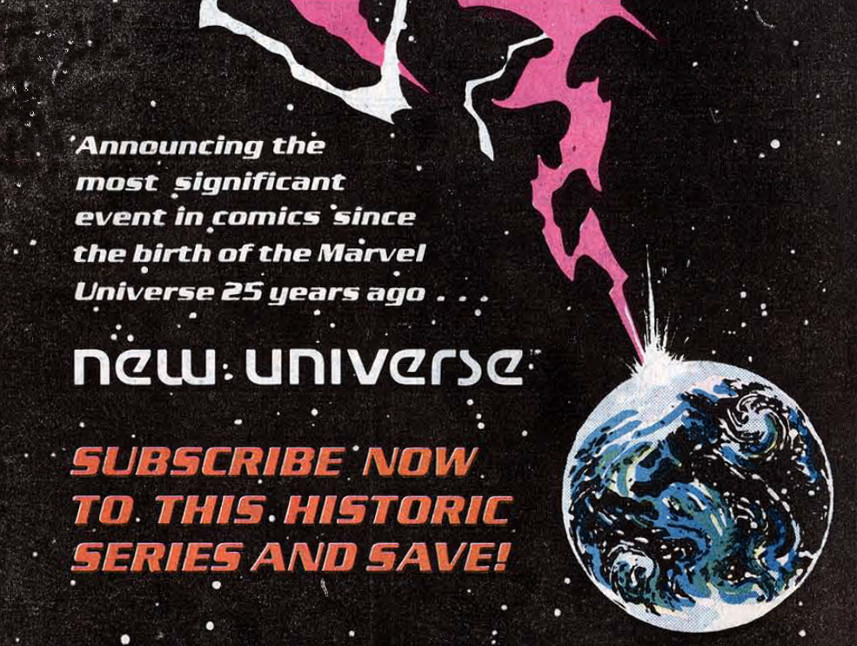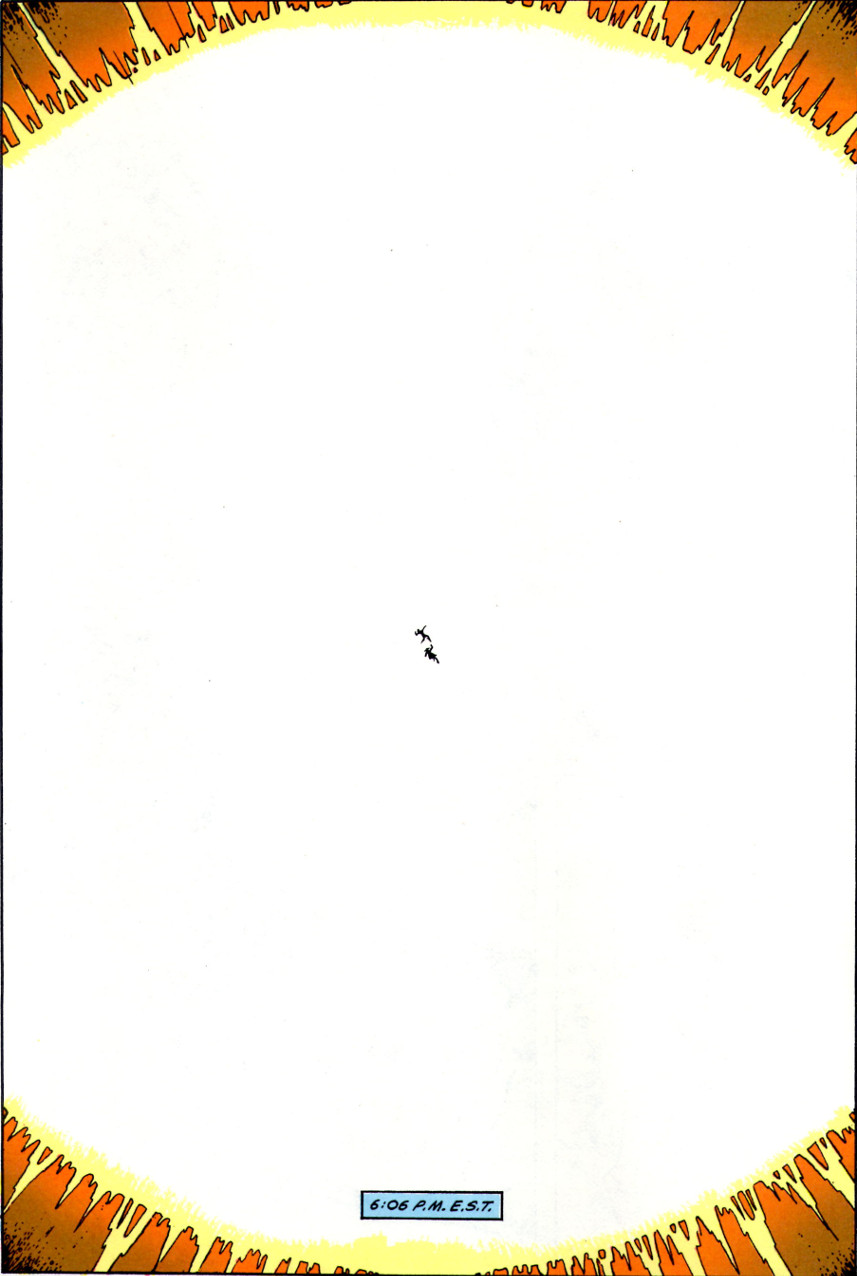New Universe – Part 1: Rise and Fall
July 22nd, 1986. The day of the White Event. The day when the world changed. That’s it! That’s the answer. Build a consistent universe from the ground up for the discerning comics reader. A universe as real and nuanced and believable as the world just outside their window. Thus began the New Universe.
The brainchild of Jim Shooter, the New Universe concept promised a wholly independent playground that would be launched to celebrate Marvel’s 25th anniversary. In Jim Shooter’s own words, the New Universe
So somebody said, “Look, this is an anniversary of a publishing event.” “Well,” I said, “there are two possibilities. You could start everything over from number one, like the Marvel universe reborn. Like the anniversary in May or June, all the titles wrap up the month before and start again the next month. Sort of like Marvel, 2nd edition, do it right and really make that spectacular.” … We were selling incredibly well so it wouldn’t be a good idea to derail the train.
So I said, “Then let’s celebrate the birth of a universe with the birth of another universe.”
I walked out of there with a development budget of about $120,000 and I’d create eight titles. It was money to spend on research, sketches, things like that.
And so eight titles were launched: D.P. 7, Jvstice, Kickers Inc., Mark Hazzard: Merc, Nightmask, Psi-Force, Spitfire and the Troublemakers, and Star Brand. (Note: I know that the ‘purists’ will point out that Jvstice should actually be spelled Justice after the name of the character but the covers clearly show a ‘v’ in place of a ‘u’ and that’s the convention I’ll follow).
The idea was to make a science-based universe, free of mythical figures, undiscovered worlds, and farcical technology. The intention was to create something much closer to hard science fiction than to fantasy. To follow the rules of a world similar to the real one but with the extra component of some people having super powers.
Unfortunately, it was obvious from the start that there was a lot wrong. The initial launch was behind schedule, the production value of the books was generally poor, and the writing was often not consistent with the premise. As time went by, some of it got better and some of it got worse. By the end of the first year, half the books were cancelled, one had been downgraded to bi-monthly and three continued on. These were supplemented by three graphics novels: The Pitt, The Draft, and The War. All told the New Universe lasted about 3 years.
The reasons for the failure seem to be firmly rooted in the usual cause of such things – the human condition. Creators seemed to think that they had free-reign to go off in any direction they wanted. Corporate and business types seemed to be very worried about the non-reoccurring costs of creating a new publishing line. Budgets were cut, schedules delayed, and so on. Ironically, the drama surrounding the rise and fall of these properties makes for much better stories than most of the fictional ones told during the initial publication run. That said, this column will not be dealing with the business side of this short-lived endeavor but rather will critique the stories themselves. The reader is encouraged to read the Comic Book Resources interview with Jim Shooter for more background on the corporate situation at Marvel during that time.
Interestingly, despite the initial failure of the line, the stories seemed to have resonated in some fashion with the fan base. Its influence went beyond its 3-year life, shaping a variety of Marvel properties over the following decades. The characters of the New Universe were revisited several times after the collapse and a variety of new stories were told, including the Untold Tales of the New Universe
and an imaginative effort by Mark Gruenwald, which brought the NU characters into the Marvel multiverse and into direct contact with the central Marvel universe. And the NU concepts have had surprising longevity with aspects, like superflow, and characters, like Starbrand and Nightmask, figuring prominently into the recent Everything Dies/Secret Wars storyline.
Background and Structure
The central idea of the New Universe (NU) is the idea of the White Event, a singular astronomical phenomenon that is responsible for the creation of the generation of superpowers amongst the Earth’s population. While neither the root cause nor the full effect of the White Event was explained initially, as the line evolved it was ‘revealed’ that the White Event was directly connected to the titular character of the Star Brand book (see image just above for a classic portrayal of Ken Connell the Star Brand) and that the percentage of humans altered was relatively low. These altered humans were collectively called paranormals.
When first launched, it was clear that each book was independent of all the others – often embarrassingly so. Whether due to creative differences or the fact that much of the initial NU work was done on a volunteer basis due to budget, Shooter’s vision didn’t take hold with a lot of the creative staff. The first issues of Spitfire and the Troublemakers and Jvstice gave particularly egregious violations of the idea that the universe would be more thoughtful and science-based and less fantastic.
Spitfire and the Troublemakers followed the extracurricular activities of a genius professor at MIT and her four precocious students. There seemed to be nothing the latter couldn’t do, including inventing advanced robotics, rapidly fixing technology they had never seen or studied, and knowing how to drive a 18-wheeler. One wondered why they were even at MIT instead of running their own businesses or starting their own universities or running the world as a cabal. Indeed, where did they manage to find the time to attend class in between having adventures here, there, and everywhere?
Jvstice went in the other direction by following an extra-dimensional warrior named Tensen from the magical realm of Spring who has been banished to Earth due to an adulterous affair with the queen (shades of Lancelot). While on Earth, Tensen metes out justice by reading people’s auras while searching to find the evil overlord of Winter, who just happens to be a drug kingpin here on Earth.
Even in Star Brand, the one book initially written by Shooter before his departure, and the one most uniquely suited to follow his vision, one can find the creative team mocking the real-world concept. In an exchange between the Star Brand and Howard Mackie and John Byrne,
the two comics creators argue, somewhat obliquely, that the very notion of realism in superhero comics can’t possibly work. In essence, the reader wants the fantastic and is willing to look past the inconsistencies to get it.
As time progressed, a central set of circumstances, many of which seem derivative of other works, were contrived to bring the various storylines into closer communion, presumably to partially bolster sales and to partially allow the creative teams to do things they couldn’t in the regular Marvel brand.
The Russian invasion of Afghanistan, which was also being discussed in Watchmen, made for the volatile geopolitical backdrop needed for the World War III finale that brought the NU to a close. The destruction of the city of Pittsburgh by the thoughtless actions of Star Brand is the trigger for the conflict. The United States Government, assuming that the event is a terrorist action carried out by paranormals from another country (possible the Soviets) reinstitutes a draft with a special emphasis on acquiring paranormals to strike back. The entire plot line is strongly influenced in both its visuals (especially the ‘sphere of devestation’)
and dystopic consequences that follow by the destruction of Tokyo and subsequent aftermath as told in Otomo’s massive manga Akira. The build-up of forces (conventional and paranormal) in the NU and the accompanying tensions eventually cascade into open hostilities which then escalate into outright war. The war is ultimately stopped by the intervention of the star child (Star Brand’s son) in nearly the same fashion as was seen in the 1984 movie 2010: The Year We Made Contact.
Since the threads of all 8 books and 3 graphic novels are interwoven, it isn’t possible to review each series in a standalone fashion. The order in which they will be presented is, perhaps, the most logical one that can be achieved. The short-lived books will be discussed first, in Part 2, with special note being made as to how these stories and their main characters transition into the larger back drop of World War III. Finally, the longer runs will be reviewed, in Part 3, in conjunction with those graphic novels that have the best overlap with the central story thread. Specifically, D.P. 7 and The Draft will form one unit while Star Brand, The Pitt, and The War will form the other.
In the next installment, New Universe: Part 2 – The Supporting Books, the four smaller runs, which set the stage for The War will be reviewed.





